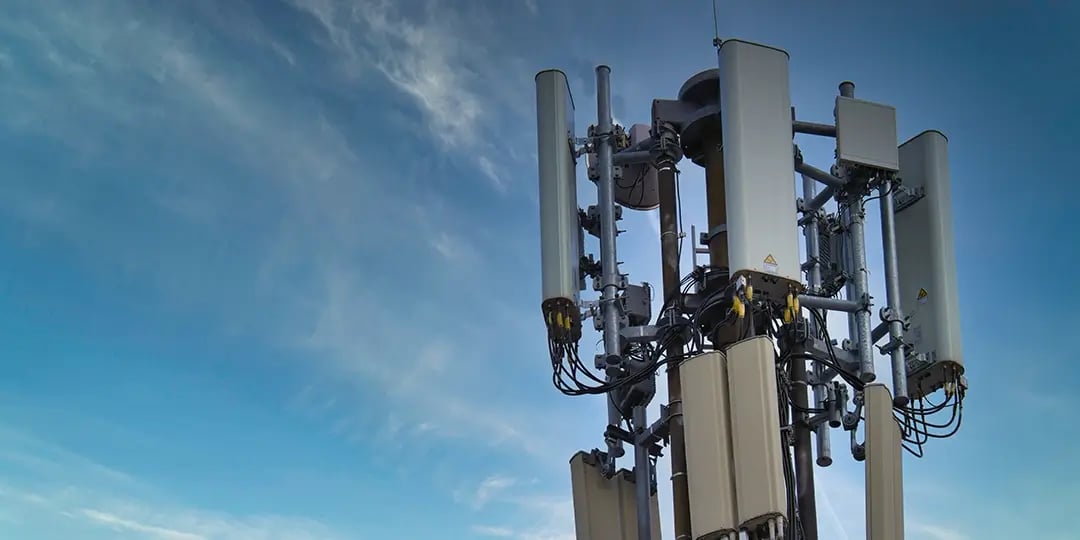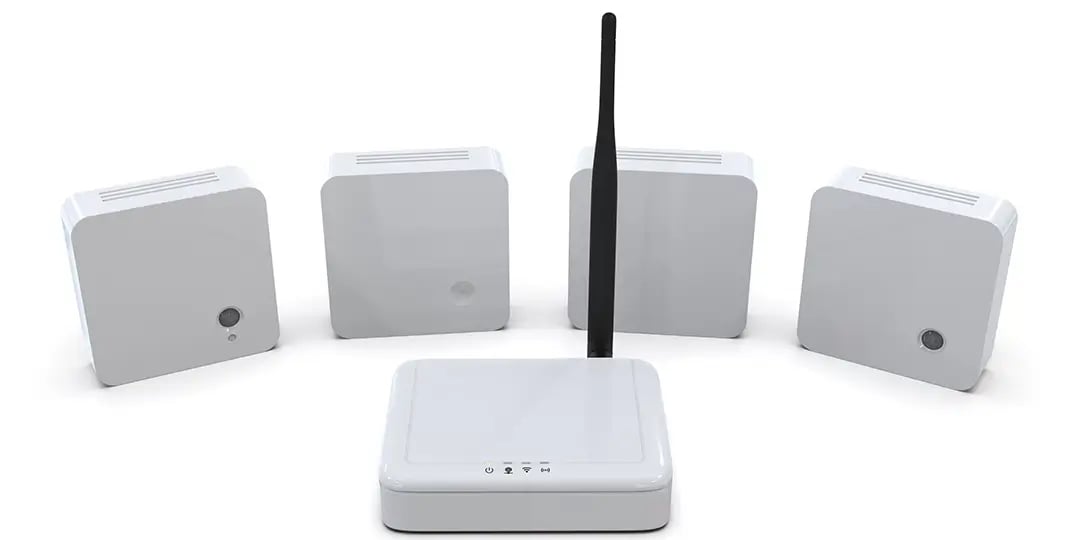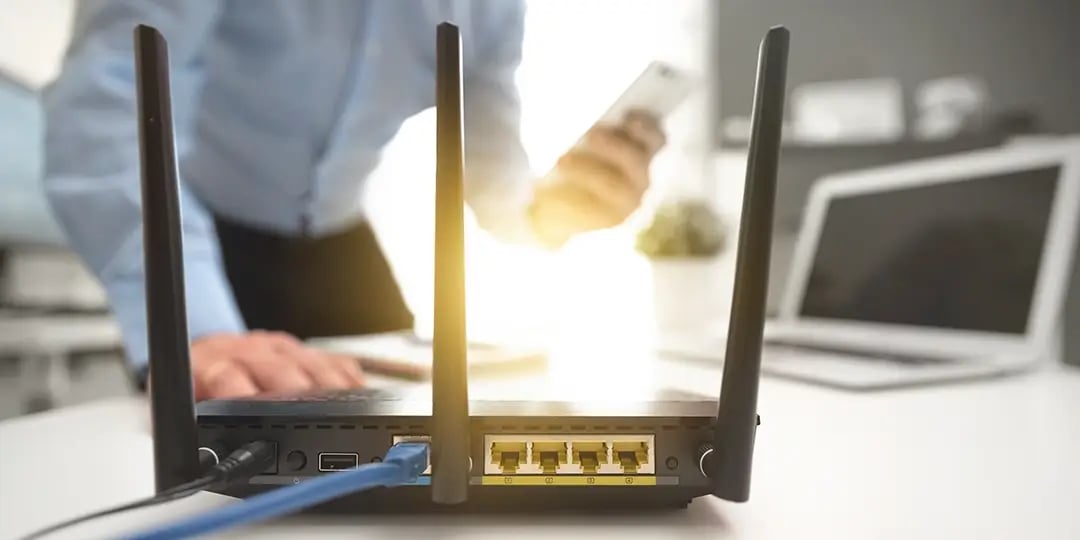When you’re looking for a water leak detection solution, a device’s communication protocol is one of the key criteria to consider. If you can’t get the right level of information about a leak within an acceptable timeframe, your solution isn’t actually very helpful.
The communication protocol - or what you might see described as “IoT connectivity” - dictates how the sensor sends you water leak information. It puts constraints on where you can operate sensors, how often you’ll be changing devices’ batteries, how much information can be sent, how often messages are sent - and even running costs.
There are so many water leak detection sensors, and your time is precious. So rather than going deep, we suggest narrowing the field by identifying the right communication protocols for your business needs.
To help, we’ve dug into the pros and cons of six of the most popular smart water leak detection sensor communication protocols.
Local Area Networks
The first set of connectivity protocols are Local Area Networks - LANs. Their connectivity has a limited range, meaning they’re best used within a single building, or even closer proximity.
WiFi
WiFi is incredibly popular, and with more than one billion WiFi networks in the world, you’re likely to find it in almost every building. Its range is usually limited to a single building, although technologies such as WiFi mesh networking are enabling physically larger networks.
Advantages of WiFi for water leak sensors
- Sends large amounts of data, fast: WiFi sends the most data, the fastest. How fast? Up to 9.6GB per second - that’s 20x faster than you need to stream a 4K video.
- Low setup costs: As WiFi networks can be found in most buildings, all the equipment is already there: simply connect your sensors to the existing network and you’re good to go.
- Great security: Every certified WiFi network has a sophisticated encryption standard called WiFi Protected Access (WPA2/WPA3).
Disadvantages of WiFi for water leak sensors
- Short range: Your devices will access WiFi signals via an access point or router. Depending on where you place this, WiFi signals (version 802.11n) only reach around 70m, and will be negatively affected by features like thick walls or metal beams. For most commercial buildings, this signal range is not enough.
- Needs a power outlet: WiFi is the most power-hungry of the protocols we’re comparing, and it usually requires mains power. Accessing a power outlet can be difficult in leak-prone places such as basements or around roofs.
- Poor integration: In most corporate and high-security buildings, WiFi networks have strict firewalls and other policies that make connecting IoT devices challenging. If you can’t, you’ll end up setting up another WiFi network from scratch.

Bluetooth
Bluetooth sends data between devices of a limited range, between 10 - 100m, depending on where you are. You’ve probably used it to connect speakers or headphones to your phone.
Advantages of Bluetooth for water leak sensors
- Great data and speed: While Bluetooth sends 20 times less data per second than WiFi, it’s still more than ample for water leak detection alerts.
- Universally available: Bluetooth is very popular, and connections can be established from almost every mobile phone and PC.
- Minimal setup and free to use: Because Bluetooth creates personal connections between only the water leak sensor and the monitoring device (like your phone or iPad) you don't need other hubs or devices. This makes it free to use.
Disadvantages of Bluetooth for water leak sensors
- Short ranges: Depending on how the Bluetooth device is configured, its range only spans 10m indoors and 100m outdoors. Unless you’re working in a residential setting, this makes remote water leak monitoring less practical; in a commercial building, you’ll need multiple monitoring devices to cover the whole building.
- Interference prone: Like WiFi, signal strength can be easily impacted by walls and metal objects. And because it operates on similar frequencies to WiFi signals, its performance can be significantly decreased around other WiFi or Bluetooth devices.
- Low security: Bluetooth has five levels of security which means it's up to the device manufacturer to implement security features. After this, the pairing process can introduce more vulnerabilities due to it using short and reusable keys. There are also very well known attacks that can happen to Bluetooth devices such as ‘Bluejacking’ and ‘Bluebugging’ which means messages can be intercepted. Using it may therefore create a weak point in your building’s security system.
- No connection to the cloud: Bluetooth is designed for devices to communicate to each other without an internet connection. If your building management system is on the cloud, then you will need a separate device to act as a bridge to the internet.

LPWANs
The next four communication protocols are Low Power Wide Area Networks - LPWANs. These communicate over wide distances in very power-efficient ways.

LTE-M
LTE-M (also called LTE CAT-M1) is a wireless communication method that uses the same cellular networks as 4G.
Advantages for of LTE-M for water leak sensors
- Sends large amounts of data, quickly and power efficiently: Of the four main LPWAN technologies, LTE-M can send the most data per second. This makes it similar to Bluetooth in being able to send far more data than water leak alerts need - but it’s much more power-efficient. LTE-M is excellent for use cases that send short bursts of high-capacity data.
- Minimal setup costs: LTE-M uses existing 4G cellular networks, which are very common globally. If you have coverage, you only need to add SIM cards for your sensors.
- Great security: As LTE-M uses the same 4G infrastructure, it adopts the same security and privacy features as these networks.
- Reliable signal in high-traffic areas: LTE-M is less likely to be disrupted than LoRaWAN or Sigfox because it uses exclusive frequencies to send messages. When combined with its transmission power, it means you’ll get high-quality signals even through several walls.
- Long range: Devices can be as far as 1km from a cellular LTE-M tower in urban areas. This can be impacted by environmental factors, but is a good benchmark as a comparison to WiFi’s short distances.
Disadvantages of LTE-M for water leak sensors
- Power-hungry when transmitting small messages: Transmit power for LTE-M is relatively high compared to the other mentioned protocols here. This is balanced by the ability to send large amounts of data quickly. Since water leak sensors do not require this high data rate, the additional power consumption adds no value and consumes more energy.
- Ongoing costs: LTE-M uses a SIM card, so there are ongoing monthly costs with use at around US$1 per MB. This may be affordable for a single device that does not transmit much data, but this can stack up quickly across multiple high output devices.
- Not universally available: LTE-M is not currently supported in most countries in Asia. Even in regions where LTE-M operates, there will be blindspots to its coverage due to cellular tower placement.

NB-IoT
Narrow-Band IoT - NB-IoT - also depends on connecting to large cellular towers but uses narrowband technology which allows hundreds more devices to exist in one space.
Advantages of NB-IoT for water leak sensors
- Good amount of data and speed for water leak sensors: NB-IoT sends data at around 128kbps - more than enough to send water leak alerts, or stream a 360p YouTube video.
- Power efficient: NB-IoT consumes a lot less power than LTE-M, and is the 3rd most power efficient out of the six protocols compared here. It's great in situations that don't require frequent, large messages.
- More devices in one space: The narrow-band technology optimizes the signal traffic, which means you can easily have hundreds of devices in one building with minimal interference.
- Great indoor coverage (if near an NB-IoT tower): NB-IoT’s performance through walls ranks at the top with LoRaWAN. However, this depends on whether you have an NB-IoT tower close to your building.
- Good security: NB-IoT is regulated by the same organization that sets the standards for 4G networks, so it has the same high security standards.
Disadvantages of NB-IoT for water leak sensors
- Limited network providers: Currently there's only one provider of NB-IoT in the UK (Vodafone) and just three providers in the US (Verizon, AT&T and T-Mobile). While coverage is improving, you still need to check signal strength in your area.

LoRaWAN
LoRaWAN doesn’t use cell towers to connect devices, it uses gateways: devices that look like a WiFi hub, or small antenna towers installed on top of roofs. LoRaWAN uses a long-range radio technology and is most suited to send small amounts of data. In our recent study, we found that it was the most popular communication protocol for water leak sensors.
Advantages of LoRaWAN for water leak sensors
- Lowest power consumption: LoRaWAN is the most power-efficient protocol if you’re sending small messages not more than once every half an hour, which fits well for water leak detection use cases.
- Good signal strength in ‘no signal’ areas: Unlike cellular connections that depend on the distance to your nearest cell tower, LoRaWAN gateways can be placed anywhere you like. This means typically harder-to-reach areas like basements or within dense buildings can receive messages reliably. It also has many interference-counteracting features that mean it has great signal strength even in indoor spaces and high-traffic areas.
- Cheap connectivity costs: LoRaWAN has relatively low connectivity costs. Once you’ve bought the gateway, it’s free to use. You may need to pay if you want to use a public gateway, but it’s generally significantly cheaper than cellular data.
- Doesn’t violate IT policies: Using a separate LoRaWAN network means you don’t interfere with your WiFI network and cause potential security or policy violations.
- Widely available: LoRaWAN is a widely used communication protocol in over 160 countries because of its license-free open standards. In 2022, it was reported that LoRaWAN holds the largest market share out of all LPWAN protocols.
- Good security: Aside from being able to have your own private network, each LoRaWAN device has its own 128-bit AES key, which allows very secure authentication.
Disadvantages of LoRaWAN for water leak sensors
- Small, infrequent amounts of data only: LoRaWAN sends data at half the speed of NB-IoT and its messages are limited to less than 250 characters. This is enough for most water leak sensors, but not if you need readings every minute.
- Expensive gateway: A single gateway will cost you around US$150 each. It’s less of an issue if you have multiple devices attached to it, but if your setup means you pair a single device to each gateway, it becomes an expensive solution.
Sigfox
Sigfox is another well-known non-cellular communication protocol that uses a gateway. It uses ultra-narrow-band technology, which means out of all the mentioned protocols, you can have the most devices per space. Sigfox devices send very small messages, less frequently than LoRaWAN.
Advantages of Sigfox for water leak sensors
Disadvantages of Sigfox for water leak sensors
- Easily disrupted: Sigfox messages take a long time to transmit and the longer this takes, the more likely the message can be disrupted by other signals. To minimize the number of messages that get disrupted, Sigfox sends multiple messages.
- Limited to sending tiny amounts of data: Each message is limited to just 12 characters, which can be enough for water leak sensors, but may constrain other IoT devices.
- Very slow speeds: It can take as long as 30 seconds to send a message, making Sigfox the slowest communication protocol in this comparison.
- Limited global coverage: Despite operating in 70+ countries, Sigfox has limited service providers and global coverage is sparse. For example, there is very little coverage in the US.

Communication protocols matter when choosing your smart water leak detection solution
How your water leak sensor communicates information is a key consideration in your purchasing process. Choose a solution that sends too little data, too infrequently, and you’ll miss catching water leaks before they become destructive. Conversely, choosing solutions that have super-high performance will see you incur unnecessary costs and changing batteries on a frequent basis.
Ultimately, you need to understand your own specific business requirements in order to make an informed decision. That said, the prevalence of both LoRaWAN and NB-IoT water leak detection solutions suggest that these are good starting points for all but the most time-critical situations.
Considering a LoRaWAN-powered smart water leak detection solution?
We'd love to chat! Book a call with our team.






